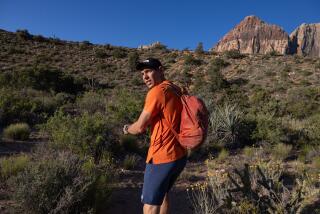Nolan A. ‘Sue’ Herndon, 88; one of Doolittle’s Raiders
- Share via
Nolan A. “Sue” Herndon, a member of the Doolittle Raiders who was held captive in the Soviet Union after participating in the audacious bombing run on Japan that gave Americans a much-needed morale boost only four months after the Japanese attacked Pearl Harbor, has died. He was 88.
Herndon, who was a navigator-bombardier in the Army Air Forces, died Oct. 7 of pneumonia at the William Jennings Bryan Dorn-VA Medical Center in Columbia, S.C., his family said.
Historians have called the April 18, 1942, attack a key event in World War II that pushed the Japanese to make strategic errors and lifted U.S. spirits when there had been little to cheer about during the early days of the conflict.
Herndon’s plane was the only one of 16 B-25 bombers to stray from then-Lt. Col. James H. Doolittle’s orders to fly to China after striking Tokyo and other cities. Officially, the War Department blamed a shortage of fuel for the plane’s landing on a Soviet airstrip outside Vladivostok.
But late in life, Herndon -- by then the sole survivor of his plane’s crew -- began sharing another theory: His plane had been on a classified mission to catalog airfields that might be used for attacks on Japan and to test the Soviet Union’s resolve as an ally by seeing if the plane would be allowed to refuel and continue to China.
“We needed information about Russia to see what they would do,” Herndon said in a 2001 story in the State newspaper in Columbia, S.C. “The whole thing was kept secret.”
When the plane touched down, the Soviet Union -- which had yet to go to war with Japan -- held the five-man crew captive for more than 13 months. They escaped after paying an Afghan smuggler $250 to take them to the British Embassy in what is now Iran.
“I think I was hooked into something I didn’t know about. I would have gone anyway. But it’s always been a burr in my side,” Herndon told the State in 2002.
A number of unusual occurrences made Herndon conclude that his B-25 had a unique extra assignment.
They included the last-minute addition of a 16th plane -- his -- to the raid, the pilot and co-pilot later taking high-level positions in military intelligence, and the plane’s carburetors being altered to burn more fuel than the other planes, providing a convenient cover story for the Soviet landing, Herndon said in the 2002 story.
Upon exiting the aircraft, pilots Edward York and Robert Emmens both spoke fluent Russian, a curiosity “that always bothered” Herndon, said Tom Casey, manager of the Doolittle Tokyo Raiders organization.
The pilots, who died years ago, never spoke about the issue, said Carroll V. Glines, the Raiders’ historian who has written three books on the subject and co-wrote Doolittle’s autobiography. “All I know is, Nolan was there and I wasn’t, but I could never find any clues to confirm that it happened that way,” Glines told The Times last week.
Calling it “a mystery,” Casey said military officials never would confirm or deny Herndon’s story.
Herndon once asked Doolittle, by then a general, why his plane unexpectedly carried navigational charts of the Soviet Union and a crew that spoke Russian.
Doolittle answered Herndon: “You’ll have to speak with somebody higher than me,” according to Casey.
“It’s one of those acts of wartime that nobody can really answer,” Casey told The Times.
None of the Raiders, who had launched their B-25s from the deck of the aircraft carrier Hornet, reached the airfields in China where they were supposed to land.
The other 15 planes crash-landed in China or their crews bailed out.
All but three of the 80 airmen survived the raid; three were captured and executed by the Japanese, and one starved to death in a prison camp.
One of the pilots, Ted Lawson, wrote a 1943 book about the attack, “Thirty Seconds Over Tokyo,” and Spencer Tracy portrayed Doolittle when the book was made into a movie the next year.
Herndon and other Raiders bristled at being labeled heroes for volunteering for the top-secret mission.
“To tell you the truth, I wish all of that would go away,” Herndon said in the State’s 2001 story. “We were just doing our job.”
Nolan Anderson Herndon was born Dec. 12, 1918, in Greenville, Texas, and had five siblings. His father was a meatpacker.
He spent two years at Texas A&M; University before joining the military in 1940. After the war, Herndon raised cattle in Edgefield, S.C., and became a wholesale grocer.
Herndon married Julia Crouch, a cousin of fellow Doolittle Raider Horace Crouch, and kept in touch with other Raiders through annual reunions.
Only 12 Raiders survive, and several are in their 90s. Still, reunions are scheduled through 2009, driven in part by an order given by their onetime commander in the Pacific.
Doolittle, who died in 1993, said the group should continue to meet until only two remain.
The final two will uncork a bottle of cognac from 1896, the year of Doolittle’s birth, and make one last toast before disbanding.
When his comrades raise their glasses in April at the 66th reunion in Dallas, Herndon will be included in their standard salute: “Gentlemen, to our good friends who have gone.”
In addition to his wife, Herndon is survived by sons Nolan A. “Sue” Herndon Jr. of West Columbia, S.C., and James M. “Debbie” Herndon of Pawleys Island, S.C.; five grandchildren; and five great-grandchildren.
More to Read
Sign up for Essential California
The most important California stories and recommendations in your inbox every morning.
You may occasionally receive promotional content from the Los Angeles Times.













